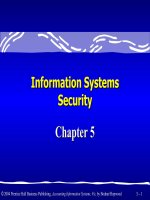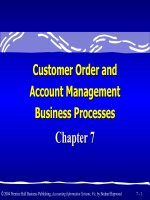THE ACCOUNTING INFORMATION SYSTEM
Bạn đang xem bản rút gọn của tài liệu. Xem và tải ngay bản đầy đủ của tài liệu tại đây (2.05 MB, 71 trang )
3-1
3-2
THE ACCOUNTING
INFORMATION SYSTEM
Accounting, Fourth Edition
3
3-3
1. Analyze the effect of business transactions on the basic accounting
equation.
2. Explain what an account is and how it helps in the recording process.
3. Define debits and credits and explain how they are used to record
business transactions.
4. Identify the basic steps in the recording process.
5. Explain what a journal is and how it helps in the recording process.
6. Explain what a ledger is and how it helps in the recording process.
7. Explain what posting is and how it helps in the recording process.
8. Explain the purposes of a trial balance.
9. Classify cash activities as operating, investing, or financing.
Study Objectives
Study Objectives
Study Objectives
Study Objectives
3-4
Debits and
Debits and
credits
credits
Debit and
Debit and
credit
credit
procedures
procedures
Stockholders’
Stockholders’
equity
equity
relationships
relationships
Summary of
Summary of
debit/credit
debit/credit
rules
rules
Accounting
Accounting
Transactions
Transactions
Accounting
Accounting
Transactions
Transactions
The Account
The Account
The Account
The Account
Steps in the
Steps in the
Recording
Recording
Process
Process
Steps in the
Steps in the
Recording
Recording
Process
Process
The
The
Recording
Recording
Process
Process
Illustrated
Illustrated
The
The
Recording
Recording
Process
Process
Illustrated
Illustrated
The Trial
The Trial
Balance
Balance
The Trial
The Trial
Balance
Balance
Analyzing
Analyzing
transactions
transactions
Summary of
Summary of
transactions
transactions
The journal
The journal
The ledger
The ledger
Chart of
Chart of
accounts
accounts
Posting
Posting
Summary
Summary
illustration of
illustration of
journalizing and
journalizing and
posting
posting
Limitations of
Limitations of
a trial balance
a trial balance
The Accounting Information System
The Accounting Information System
The Accounting Information System
The Accounting Information System
3-5
The Accounting Information System
The Accounting Information System
The Accounting Information System
The Accounting Information System
Accounting Information System
System of
►
collecting and
►
processing transaction data and
►
communicating financial information to decision
makers.
Most businesses use computerized accounting (EDP)
systems.
3-6
Transactions are economic events that require
recording in the financial statements.
Not all activities represent transactions.
Assets, liabilities, or stockholders’ equity items
change as a result of some economic event.
Dual effect on the accounting equation.
Accounting Transactions
Accounting Transactions
Accounting Transactions
Accounting Transactions
3-7
Question:
Question: Are the following events recorded in the
accounting records?
Event
Purchase
computer.
Criterion
Is the financial position (assets, liabilities, or
stockholders’ equity) of the company changed?
Pay rent.
Record/ Don’t
Record
Accounting Transactions
Accounting Transactions
Accounting Transactions
Accounting Transactions
Discuss
guided trip
options with
potential
customer.
Illustration 3-1
3-8
Assets
AssetsAssets
Assets
Liabilities
LiabilitiesLiabilities
Liabilities
Stockholders’
Stockholders’
Equity
Equity
Stockholders’
Stockholders’
Equity
Equity
=
+
Analyzing Transactions
SO 1
SO 1 Analyze the effect of business transactions on the basic accounting equation.
Basic Accounting Equation
Accounting Transactions
Accounting Transactions
Accounting Transactions
Accounting Transactions
The process of identifying the specific effects of economic
events on the accounting equation.
3-9
Analyzing Transactions
SO 1
SO 1 Analyze the effect of business transactions on the basic accounting equation.
Accounting Transactions
Accounting Transactions
Accounting Transactions
Accounting Transactions
Illustration 3-2
Expanded accounting equation
3-10
Illustration:
Illustration: 1. On October 1, cash of $10,000 is invested in Sierra
Corporation by investors in exchange for $10,000 of common stock.
Accounting Transactions
Accounting Transactions
Accounting Transactions
Accounting Transactions
1. +10,000 +10,000
SO 1
SO 1 Analyze the effect of business transactions on the basic accounting equation.
3-11
2. On October 1, Sierra borrowed $5,000 from Castle Bank by signing
a 3-month, 12%, $5,000 note payable.
Accounting Transactions
Accounting Transactions
Accounting Transactions
Accounting Transactions
1. +10,000 +10,000
2. +5,000 +5,000
SO 1
SO 1 Analyze the effect of business transactions on the basic accounting equation.
3-12
3. On October 2, Sierra purchased equipment by paying $5,000 cash
to Superior Equipment Sales Co.
Accounting Transactions
Accounting Transactions
Accounting Transactions
Accounting Transactions
3. -5,000 +5,000
1. +10,000 +10,000
2. +5,000 +5,000
SO 1
SO 1 Analyze the effect of business transactions on the basic accounting equation.
3-13
4. On October 2, Sierra received a $1,200 cash advance from R. Knox,
a client.
Accounting Transactions
Accounting Transactions
Accounting Transactions
Accounting Transactions
4. +1,200 +1,200
3. -5,000 +5,000
1. +10,000 +10,000
2. +5,000 +5,000
SO 1
SO 1 Analyze the effect of business transactions on the basic accounting equation.
3-14
5. On October 3, Sierra received $10,000 in cash from Copa Company
for guide services performed.
Accounting Transactions
Accounting Transactions
Accounting Transactions
Accounting Transactions
4. +1,200 +1,200
5. +10,000 +10,000
3. -5,000 +5,000
1. +10,000 +10,000
2. +5,000 +5,000
SO 1
SO 1 Analyze the effect of business transactions on the basic accounting equation.
3-15
6. On October 3, Sierra Corporation paid its office rent for the month
of October in cash, $900.
Accounting Transactions
Accounting Transactions
Accounting Transactions
Accounting Transactions
4. +1,200 +1,200
5. +10,000 +10,000
6. -900 -900
3. -5,000 +5,000
1. +10,000 +10,000
2. +5,000 +5,000
SO 1
SO 1 Analyze the effect of business transactions on the basic accounting equation.
3-16
7. On October 4, Sierra paid $600 for a one-year insurance policy that
will expire next year on September 30.
Accounting Transactions
Accounting Transactions
Accounting Transactions
Accounting Transactions
4. +1,200 +1,200
5. +10,000 +10,000
6. -900 -900
7. -600 +600
3. -5,000 +5,000
1. +10,000 +10,000
2. +5,000 +5,000
SO 1
SO 1 Analyze the effect of business transactions on the basic accounting equation.
3-17
8. On October 5, Sierra purchased supplies on account from Aero
Supply for $2,500.
Accounting Transactions
Accounting Transactions
Accounting Transactions
Accounting Transactions
4. +1,200 +1,200
5. +10,000 +10,000
6. -900 -900
7. -600 +600
8. +2,500 +2,500
3. -5,000 +5,000
1. +10,000 +10,000
2. +5,000 +5,000
SO 1
SO 1 Analyze the effect of business transactions on the basic accounting equation.
3-18
10. On October 20, Sierra paid a $500 dividend.
Accounting Transactions
Accounting Transactions
Accounting Transactions
Accounting Transactions
4. +1,200 +1,200
5. +10,000 +10,000
6. -900 -900
7. -600 +600
8. +2,500 +2,500
10. -500 -
500
3. -5,000 +5,000
1. +10,000 +10,000
2. +5,000 +5,000
SO 1
SO 1 Analyze the effect of business transactions on the basic accounting equation.
3-19
11. Employees have worked two weeks, earning $4,000 in salaries,
which were paid on October 26.
Accounting Transactions
Accounting Transactions
Accounting Transactions
Accounting Transactions
4. +1,200 +1,200
5. +10,000 +10,000
6. -900 -900
7. -600 +600
8. +2,500 +2,500
10. -500 -
500
11. -4,000 -4,000
3. -5,000 +5,000
1. +10,000 +10,000
2. +5,000 +5,000
3-20
3-21
Record of increases and decreases in
a specific asset, liability, equity,
revenue, or expense item.
Debit = “Left”
Credit = “Right”
Account
Account
An Account can
An Account can
be illustrated in a
be illustrated in a
T-Account form.
T-Account form.
SO 2 Explain what an account is and how it helps in the recording process.
SO 2 Explain what an account is and how it helps in the recording process.
The Account
The Account
The Account
The Account
3-22
Double-entry
Double-entry system
►
Each transaction must affect two or more accounts to
keep the basic accounting equation in balance.
►
Recording done by debiting at least one account and
crediting another.
►
DEBITS
must equal
must equal CREDITS.
SO 3 Define debits and credits and explain their use in recording business transactions.
SO 3 Define debits and credits and explain their use in recording business transactions.
Debit and Credit Procedures
The Account
The Account
The Account
The Account
3-23
Account Name
Debit / Dr.
Credit / Cr.
If Debits are
greater than
greater than Credits, the account will
have a debit balance.
$10,000 Transaction #2$3,000
$15,000
$15,000
8,000Transaction #3
Balance
Transaction #1
SO 3 Define debits and credits and explain their use in recording business transactions.
SO 3 Define debits and credits and explain their use in recording business transactions.
Debit and Credit Procedures
Debit and Credit Procedures
Debit and Credit Procedures
Debit and Credit Procedures
3-24
Account Name
Debit / Dr.
Credit / Cr.
$10,000 Transaction #2$3,000
Balance
Transaction #1
$1,000
$1,000
8,000 Transaction #3
SO 3 Define debits and credits and explain their use in recording business transactions.
SO 3 Define debits and credits and explain their use in recording business transactions.
Debit and Credit Procedures
Debit and Credit Procedures
Debit and Credit Procedures
Debit and Credit Procedures
If Credits are greater than Debits, the account will
have a credit balance.
3-25
Assets - Debits should
exceed credits.
Liabilities – Credits should
exceed debits.
The normal balance is on
the increase side.
Dr./Cr. Procedures for Assets and Liabilities
Dr./Cr. Procedures for Assets and Liabilities
Dr./Cr. Procedures for Assets and Liabilities
Dr./Cr. Procedures for Assets and Liabilities
Chapter
3-23
Assets
Assets
Debit / Dr.
Credit / Cr.
Normal Balance
Normal Balance
Chapter
3-24
Liabilities
Liabilities
Debit / Dr.
Credit / Cr.
Normal Balance
Normal Balance
SO 3 Define debits and credits and explain their use in recording business transactions.
SO 3 Define debits and credits and explain their use in recording business transactions.









